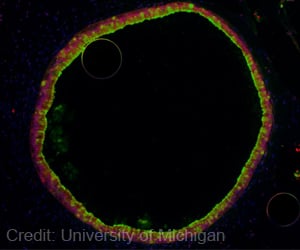A new study of more than 6,000 genes in a common species of yeast has identified the pathways that govern the instability of GAA/TTC repeats.

Working with collaborators at Tufts University, researchers at the Georgia Institute of Technology identified genetic deficiencies associated with the instability of the repeats in four different classes of genes that control replication, transcription initiation, checkpoint response and telomere maintenance. They were surprised to find that the GAA/TTC repeats could promote gene expression in yeast, suggesting that the repeats may play both positive and negative roles in cells.
While the study examined the repeat metabolisms in the yeast Saccharomyces cerevisiae, the researchers believe their discoveries may have implications for human disease because many components of genetic machinery have been conserved in evolution.
The study was reported online Sept. 6 in the journal Molecular Cell. The research was supported by the National Institutes of Health (NIH) and the National Science Foundation (NSF).
The expansions occur in GAA/TTC sequences located on the FXN gene that plays a vital role in cell metabolism. Patients with Friedreich's ataxia can have as many as 1,700 copies of the nucleotide sequence, compared to fewer than 65 copies in individuals without the genetic expansion. Although not yet observed in humans, in yeast the expanded repeats can cause chromosomal fragility, which – despite cellular repair mechanisms – can produce errors resulting in dramatic genomic rearrangements.
"How these expansions happen is a very mysterious process, and we do not know why some people get the disease and some people do not," said Kirill Lobachev, an associate professor in Georgia Tech's School of Biology. "We are trying to develop a simplistic way to determine what individuals may be predisposed to the disease and to find the genotypes where these expansions occur with great frequency."
Advertisement
The connection between genomic expansion and genes that initiate transcription came as a surprise.
Advertisement
The ability of the repeats to affect the activity of genes may indicate a broader effect on the genome, and if the effect is also seen in humans, could account for some of the subtle differences between individuals.
"By some estimates, there may be a thousand locations in our chromosomes where these repeats can expand," said Lobachev. "Probably each person differs in the number of repeats in specific locations. This is important because of their ability to change gene expression."
Among the next steps in the research is to determine how the expansions occur in cells that aren't dividing, such as neurons. The genetic mechanisms involved in cell replication offer clear opportunities for repeat expansions, but the mechanism for repeat amplification in non-dividing cells remains a mystery. The researchers believe the finding that GAA/TTC repeats can promote transcription provides clues for understanding what is going on in terminally differentiated cells.
Why repeats with the detrimental ability to expand have remained a part of the genomes also remains a question. Genetic processes that hinder an organism's competitiveness are normally eliminated during the process of evolution.
"Perhaps these repeats play a positive role in the cell when they are small, but because of their ability to expand, they sometimes get out of control and become larger," Lobachev said.
The findings reported in the yeast, which is commonly used in wine-making and brewing, may help chart a new course in human studies. Scientists often begin genetic research with simpler organisms such as yeast, and use the findings to provide direction for examining similar mechanisms in humans.
"A lot of the processes that are going on in our cells and in yeast cells are the same," Lobachev noted. "These processes are highly conserved throughout evolution. The history of biology tells us that most probably what we find in yeast is going to turn out to be true in humans."
Lobachev hopes the study will lead to new research, both in yeast genetics and humans.
"We have built a map for future analysis so that when people sequence the genome and find deficiencies in particular genes, that will be a clear prediction that individuals with those deficiencies will be predisposed to instability," Lobachev said. "There are now several directions for us and other labs to pursue to see what is really happening here.
Source-Eurekalert










